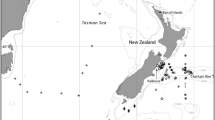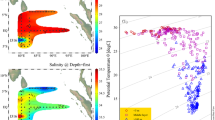Abstract
A quantitative analysis of coccoliths is presented in 18 core-top samples ranging between 26° N and 21° N and covering two major deep brine pools in the northern part of the Red Sea. Non-brine sites are characterized by rich coccoliths that may reach up to 3.31 × 109 coccoliths/g made by 22 species, whereas brine sites of Shaban and Kebrit Deeps with additional two non-brine sites are characterized by a decline in coccoliths/g (3.25 × 108 coccoliths/g), Shannon diversity, CaCO3 (%), and high TOC (%). Carbonate dissolution, inferred by qualitative observation and quantitative indices, was only observed at one brine site GeoB7828 in Kebrit Deep. This suggests that the decline in coccolith assemblages may not entirely be attributed to carbonate dissolution. The major decline, however, is probably related to the suspension of fecal pellets and marine aggregates containing delicate coccolith shields within a nepheloid layer and subsequently grazed by zooplankters in which reduced the numbers of coccolith that reached the bottom of the brine sites, or alternatively a deep-sea flow current that carried and remobilized some suspended particles outside the brine pool. Latitudinal fluctuations of eutrophic/oligotrophic coccoliths suggest profound trophic changes in the photic zone in the northern part of the Red Sea. C. braarudii, a valuable nutrient-indicator species is here reported for the first time, along with G. oceanica, H. carteri as well as biogenic opal dominating the assemblage between 26° N and 24° N, suggesting elevated nutrient conditions and supporting recent high chl-a records, whereas areas between 21° N and 23° N lie under oligotrophic conditions due to the presence of U. sibogae, U. tenuis, R. clavigera, F. profunda, and S. pulchra.











Similar content being viewed by others
References
Raitsos, D.E.; Pradhan, Y.; Brewin, R.J.; Stenchikov, G.; Hoteit, I.: Remote sensing the phytoplankton seasonal succession of the Red Sea. PLoS ONE 8(6), e64909 (2013). https://doi.org/10.1371/journal.pone.0064909
Eshel, G.; Naik, N.H.: Climatological coastal jet collision, intermediate water formation, and the general circulation of the Red Sea. J. Phys. Oceanogr. 27(7), 1233–1257 (1997)
Weikert, H.: Plankton and the pelagic environment. In: Edwards, A.J, Head, S.M (eds.) Key Environments: Red Sea. Pergamon Press, Oxford, pp. 90–111 (1987)
Acker, J.; Leptoukh, G.; Shen, S.; Zhu, T.; Kempler, S.: Remotely-sensed chlorophyll a observations of the northern Red Sea indicate seasonal variability and influence of coastal reefs. J. Mar. Syst. 69(3–4), 191–204 (2008)
Alkawri, A.; Gamoyo, M.: Remote sensing of phytoplankton distribution in the Red Sea and Gulf of Aden. Acta Oceanol. Sin. 33(9), 93–99 (2014)
Qurban, M.A.; Balala, A.C.; Kumar, S.; Bhavya, P.; Wafar, M.: Primary production in the northern Red Sea. J. Mar. Syst. 132, 75–82 (2014)
Qurban, M.A.; Wafar, M.; Jyothibabu, R.; Manikandan, K.: Patterns of primary production in the Red Sea. J. Mar. Syst. 169, 87–98 (2017)
Zhan, P.; Krokos, G.; Guo, D.; Hoteit, I.: Three-dimensional signature of the Red Sea Eddies and Eddy-induced transport. Geophys. Res. Lett. 46(4), 2167–2177 (2019)
Broerse, A.; Brummer, G.-J.; Van Hinte, J.: Coccolithophore export production in response to monsoonal upwelling off Somalia (northwestern Indian Ocean). Deep Sea Res. Part II 47(9–11), 2179–2205 (2000)
Hartmann, M.; Scholten, J.C.; Stoffers, P.; Wehner, F.: Hydrographic structure of brine-filled deeps in the Red Sea—new results from the Shaban, Kebrit, Atlantis II, and Discovery Deep. Mar. Geol. 144(4), 311–330 (1998)
Schmidt, M.; Al-Farawati, R.; Botz, R.: Geochemical classification of brine-filled Red Sea deeps. In: The Red Sea, pp. 219–233. Springer, Berlin (2015).
Kaartvedt, S.; Antunes, A.; Røstad, A.; Klevjer, T.A.; Vestheim, H.: Zooplankton at deep Red Sea brine pools. J. Plankton Res. 38(3), 679–684 (2016)
Ryan, W.B.; Thorndike, E.M.; Ewing, M.; Ross, D.A.: Suspended matter in the Red Sea brines and its detection by light scattering. In: Hot Brines and Recent Heavy Metal Deposits in the Red Sea, pp. 153–157. Springer, Berlin (1969).
Seeberg-Elverfeldt, I.A.; Lange, C.B.; Arz, H.W.; Pätzold, J.; Pike, J.: The significance of diatoms in the formation of laminated sediments of the Shaban Deep, Northern Red Sea. Mar. Geol. 209(1–4), 279–301 (2004)
Seeberg-Elverfeldt, I.A.; Lange, C.B.; Pätzold, J.; Kuhn, G.: Laminae type and possible mechanisms for the formation of laminated sediments in the Shaban Deep. Northern Red Sea. Ocean Sci. 1, 113–126 (2005). https://doi.org/10.5194/os-1-113-2005
Abu-Zied, R.H.: Effect of the Red Sea brine-filled deeps (Shaban and Kebrit) on the composition and abundance of benthic and planktonic foraminifera. Arab. J. Geosci. 6(10), 3809–3826 (2013)
Billard, C.; Inouye, I.: What is new in coccolithophore biology? In: Coccolithophores, pp. 1–29. Springer, Berlin (2004)
McIntyre, A.; Bé, A.W.; Roche, M.B.: Modern Pacific Coccolithophorida: a paleontological thermometer. Trans. N. Y. Acad. Sci. 32(6 Series II), 720–731 (1970)
Okada, H.; Honjo, S.: The distribution of oceanic coccolithophorids in the Pacific. Deep Sea Res. Oceanogr. Abstr. 4, 355–374 (1973)
Winter, A.; Jordan, R.W.; Roth, P.H.: Biogeography of living coccolithophores in ocean waters. In: Winter, A., Siesser, W.G. (eds.) Coccolithophores, pp 161–176. Cambridge University Press, Cambridge (1994)
Baumann, K.-H.; Andruleit, H.; Böckel, B.; Geisen, M.; Kinkel, H.: The significance of extant coccolithophores as indicators of ocean water masses, surface water temperature, and palaeoproductivity: a review. Paläontol. Z. 79(1), 93–112 (2005)
McIntyre, A.; McIntyre, R.: Coccolith concentrations and differential solution in oceanic sediments. In: The Micropaleontology of Oceans, pp. 253–261. Cambridge University Press, Cambridge (1971).
Roth, P.H.; Berger, W.H.: Distribution and dissolution of Coccoliths in the South and Central Pacific. Cushman Found. Foraminifer. Res. 13, 87–113 (1975)
Honjo, S.; Manganini, S.J.; Cole, J.J.: Sedimentation of biogenic matter in the deep ocean. Deep Sea Res. Part A Oceanogr. Res. Pap. 29(5), 609–625 (1982)
Ziveri, P.; Thunell, R.: Coccolithophore export production in Guaymas Basin, Gulf of California: response to climate forcing. Deep Sea Res. Part II 47(9–11), 2073–2100 (2000)
Legge, H.L.; Mutterlose, J.; Arz, H.W.: Climatic changes in the northern Red Sea during the last 22,000 years as recorded by calcareous nannofossils. Paleoceanography 21, PA1003 (2006). https://doi.org/10.1029/2005PA001142
Malinverno, E.; Triantaphyllou, M.; Stavrakakis, S.; Ziveri, P.; Lykousis, V.: Seasonal and spatial variability of coccolithophore export production at the South-Western margin of Crete (Eastern Mediterranean). Mar. Micropaleontol. 71(3–4), 131–147 (2009)
Saavedra-Pellitero, M.; Flores, J.-A.; Baumann, K.-H.; Sierro, F.-J.: Coccolith distribution patterns in surface sediments of Equatorial and Southeastern Pacific Ocean. Geobios 43(1), 131–149 (2010)
Stolz, K.; Baumann, K.-H.; Mersmeyer, H.: Extant coccolithophores from the western equatorial Indian Ocean off Tanzania and coccolith distribution in surface sediments. Micropaleontology 61(6), 473–488 (2015)
McIntyre, A.: The coccolithophorida in Red Sea sediments. In: Hot Brines and Recent Heavy Metal Deposits in the Red Sea, pp. 299–305. Springer, Berlin (1969).
Okada, H.; Honjo, S.: Distribution of coccolithophores in marginal seas along the western Pacific Ocean and in the Red Sea. Mar. Biol. 31(3), 271–285 (1975)
Kleijne, A.; Kroon, D.; Zevenboom, W.: Phytoplankton and foraminiferal frequencies in northern Indian Ocean and Red Sea surface waters. Neth. J. Sea Res. 24(4), 531–539 (1989)
Kleijne, A.: Holococcolithophorids from the Indian Ocean, Red Sea, Mediterranean Sea and North Atlantic Ocean. Mar. Micropaleontol. 17(1–2), 1–76 (1991)
Kleijne, A.: Extant Rhabdosphaeraceae (coccolithophorids, class Prymnesiophyceae) from the Indian Ocean, Red Sea, Mediterranean Sea and North Atlantic Ocean. vol. 100-101. Nationaal Natuurhistorisch Museum Leiden (1992).
Winter, A.; Reiss, Z.; Luz, B.: Distribution of living coccolithophore assemblages in the Gulf of Elat (‘Aqaba). Mar. Micropaleontol. 4, 197–223 (1979)
Pätzold, J., Bohrmann, G., Hübscher, C.: Black Sea-Mediterranean-Red Sea, Cruise No. 52, January 2–March 27, 2002, Istanbul-Limassol, vol. 3. Leitstelle Meteor Institut für Meereskunde der Universität Hamburg (2003)
Bordiga, M.; Bartol, M.; Henderiks, J.: Absolute nannofossil abundance estimates: quantifying the pros and cons of different techniques. Rev. Micropaléontol. 58(3), 155–165 (2015)
Koch, C.; Young, J.R.: A simple weighing and dilution technique for determining absolute abundances of coccoliths from sediment samples. J. Nannoplankton Res. 29(1), 67–69 (2007)
Hammer, Ø.; Harper, D.A.; Ryan, P.D.: PAST: paleontological statistics software package for education and data analysis. Palaeontol. Electron. 4(1), 9 (2001)
Kameo, K.: Late Pliocene Caribbean surface water dynamics and climatic changes based on calcareous nannofossil records. Palaeogeogr. Palaeoclimatol. Palaeoecol. 179(3–4), 211–226 (2002)
Dittert, N.; Baumann, K.-H.; Bickert, T.; Henrich, R.; Huber, R.; Kinkel, H.; Meggers, H.: Carbonate dissolution in the deep-sea: methods, quantification and paleoceanographic application. In: Use of Proxies in Paleoceanography, pp. 255–284. Springer, Berlin (1999)
Boeckel, B.; Baumann, K.-H.: Distribution of coccoliths in surface sediments of the south-eastern South Atlantic Ocean: ecology, preservation and carbonate contribution. Mar. Micropaleontol. 51(3–4), 301–320 (2004)
Okada, H.: Biogeographic control of modern nannofossil assemblages in surface sediments of Ise Bay, Mikawa Bay and Kumano-nada, off coast of central Japan. Memorie di scienze Geologiche, gia Memorie degli Istituti di Geologia e Mineralogia dell’Universita di Padova 43, 431–449 (1992)
Heiri, O.; Lotter, A.F.; Lemcke, G.: Loss on ignition as a method for estimating organic and carbonate content in sediments: reproducibility and comparability of results. J. Paleolimnol. 25(1), 101–110 (2001)
Roth, P.H.; Coulbourn, W.T.: Floral and solution patterns of coccoliths in surface sediments of the North Pacific. Mar. Micropaleontol. 7(1), 1–52 (1982)
Blum, N.; Puchelt, H.: Sedimentary-hosted polymetallic massive sulfide deposits of the Kebrit and Shaban Deeps, Red Sea. Miner. Depos. 26(3), 217–227 (1991)
Honjo, S.; Roman, M.R.: Marine copepod fecal pellets: production, preservation and sedimentation. J. Mar. Res. 36(1), 45–57 (1978)
Honjo, S.: Coccoliths: production, transportation and sedimentation. Mar. Micropaleontol. 1, 65–79 (1976)
Mayers, K.M.; Poulton, A.J.; Daniels, C.J.; Wells, S.; Woodward, E.; Tarran, G.A.; Widdicombe, C.E.; Mayor, D.; Atkinson, A.; Giering, S.: Growth and mortality of coccolithophores during spring in a temperate Shelf Sea (Celtic Sea, April 2015). Prog. Oceanogr. 177, 101928 (2019)
McIntyre, A.; Bé, A.W.: Modern coccolithophoridae of the Atlantic Ocean—I. Placoliths and cyrtoliths. In: Deep Sea Research and Oceanographic Abstracts, vol. 5, pp. 561–597 (1967)
Dimiza, M.D.; Triantaphyllou, M.V.; Malinverno, E.; Psarra, S.; Karatsolis, B.-T.; Mara, P.; Lagaria, A.; Gogou, A.: The composition and distribution of living coccolithophores in the Aegean Sea (NE Mediterranean). Micropaleontology 521–540 (2015)
Ziveri, P.; Baumann, K.-H.; Böckel, B.; Bollmann, J.; Young, J.R.: Biogeography of selected Holocene coccoliths in the Atlantic Ocean. In: Coccolithophores, pp. 403–428. Springer, Berlin (2004)
Cachao, M.; Moita, M.: Coccolithus pelagicus, a productivity proxy related to moderate fronts off Western Iberia. Mar. Micropaleontol. 39(1–4), 131–155 (2000)
Parente, A.; Cachão, M.; Baumann, K.-H.; de Abreu, L.; Ferreira, J.: Morphometry of Coccolithus pelagicus sl (Coccolithophore, Haptophyta) from offshore Portugal, during the last 200 kyr. Micropaleontology 50(Suppl_1), 107–120 (2004)
Giraudeau, J.: Distribution of recent nannofossils beneath the Benguela system: southwest African continental margin. Mar. Geol. 108(2), 219–237 (1992)
Dimiza, M.D.; Triantaphyllou, M.V.; Malinverno, E.: New evidence for the ecology of Helicosphaera carteri in polluted coastal environments (Elefsis Bay, Saronikos Gulf, Greece). J. Nannoplankton Res. 34, 37–43 (2014)
Ehrhardt, A.; Hübscher, C.: The northern Red Sea in transition from rifting to drifting-lessons learned from ocean deeps. In: The Red Sea, pp. 99–121. Springer, Berlin (2015)
Acknowledgements
This project was funded by the Deanship of Scientific Research (DSR), King Abdulaziz University, Jeddah, under grant No. D-278-150-1440. The author gratefully acknowledges the DSR technical and financial support. I would like to thank the two anonymous reviewers and Drs. Jürgen Pätzold, Karl Baumann, Iyad Zalmout, Mohamed El-Hag, Aaron Avery, and David Bord for initial constructive comments and suggestions that improve the initial manuscript.
Author information
Authors and Affiliations
Corresponding author
Electronic supplementary material
Below is the link to the electronic supplementary material.
Rights and permissions
About this article
Cite this article
Aljahdali, M.H. Distribution and Diversity of Coccolithophores in Surface Sediments of the Northern Red Sea: Coccolith Accumulation in Brine Pools and Observation of Productivity. Arab J Sci Eng 46, 601–615 (2021). https://doi.org/10.1007/s13369-020-05021-4
Received:
Accepted:
Published:
Issue Date:
DOI: https://doi.org/10.1007/s13369-020-05021-4




